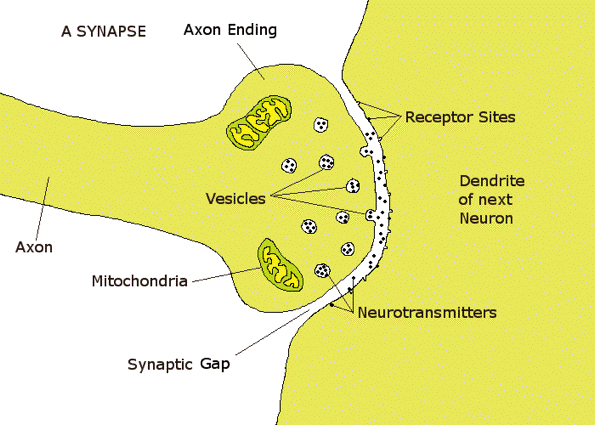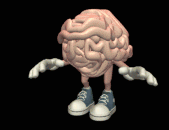
Nervous System
The nervous system is the potentially the most important body system in the human body. The nervous system is responsible for sending messages to the rest of the body. The nervous system is the command center of the body. It instructs the rest of the body through electrochemical signals. The basic unit of the nervous system is a neuron. The first picture in the gallery below diagram of a neuron is shown below in the gallery. The area between the dendrite and axon of a neuron is called a synapse. The second picture in the gallery is a diagram of a synapse. Nerves often appear within the body in bundles called ganglia. It is in ganglia that basic commands originate from. The brain is a unique part of the nervous system, as it contains 100 billion neurons and can process massive amounts of data. Therefore the brain instructs the rest of the body. The nervous system overall is split into two very distinctive parts: the Central Nervous system (CNS) and the Peripheral Nervous system (PNS). The CNS consists of the brain and the spinal cord, while the PNS picks up stimuli. The PNS cannot issue commands; instead, transmits information about the outside world into the CNS to be processed. The CNS processes stimuli, and sends responses to act on those stimuli. There are three major neurons of the human body. They are the sensory neurons, interneurons, and motor neurons. Sensory neurons detect and record stimuli. The interneurons make sense of the sensory input and transit a message to the spinal cord and later the brain. Motor neurons instruct muscles to contract.
The nerve impulses used to send information throughout the body are a very complicated process. The process is initiated at the axon hillock, the place where the axon meets the cell body. This area is hit by electrical impulses from neurons connected to it. When the electrical impulses hit a certain point called the threshold, the neuron initiates its own electrical impulse. The electrical impulse is created through the opening and closing of of sodium ion channels. Before a neural impulse (resting potential), Na+ is mostly concentrated outside of the membrane of the axon, so the outside is positive and the inside is negative.. As the signal is reached, the sodium ion channels actively transport enough Na+ into the axon that the charges are reversed. This difference in charge is the neural impulse. Behind the neural impulse, the sodium ion channels restore the neuron back into its original state, returning the neutron to its resting potential. The third picture in the gallery bellow describes this.
Transmission between the axon of a neuron and the dendrite of another occurs between the two neurons, in the synapse. Tiny organelles called vesicles in the axon are forced down the small area of the axon. The vesicles release neurotransmitters, small chemicals that trigger receptors on the surface of the dendrite, signaling the next neuron to continue to transfer the message.
The brain is divided into multiple sections. These sections are labelled in the 5th picture in the gallery below. Left click on the image to have it expand. The cerebrum consists of the four labelled lobes on the diagram. The frontal lobe controls our emotions and personality. The parietal lobe processes sensory information, especially language and math. The Occipital lobe is the visual processing center. The temporal lobe perceives auditory information. The Corpus Callosum joins the 2 hemispheres of the brain. The spinal cord (not labelled on the diagram-it extends from the medulla oblongata) transmits information. The brainstem (pons and medulla oblongata) controls involuntary functions of the body, like the beating of the heart. The pituitary gland produces various hormones that usually control other glands. An example of this would be Human Growth Hormone(HGH), which triggers growth in the body. The hypothalamus, another gland in the brain, also produces hormones, and mostly controls the pituitary gland.
The organization of the nervous system extends further than the PNS and the CNS. The PNS is further divided into multiple sections. The somatic nervous system describes things you can control, like skeletal muscles (muscular system page). The other half of the PNS is the autonomic nervous system, which consists of processes you are unable to control. The autonomic system essentially regulates the function of the body, like controlling smooth and cardiac muscle tissue. The autonomic system is further divided into 3 sections: the sympathetic, parasympathetic, and enteric. Sympathetic controls the fight or flight response in the body. The parasympathetic promotes a return to self-maintenance functions, or essentially returns your body to normal after the sympathetic system kicks in. The enteric division controls the activity of the digestive tract, the pancreas, and the gallbladder. Pictures 6 and 7 describe these differences in a graphic format.
Two examples of diseases in the nervous system are a stroke and Alzheimer’s disease. A stroke is a breaking of blood vessels in the brain. This causes internal bleeding and damages the brain. Another type of a malfunction of the nervous system is Alzheimer’s disease. Alzheimer's disease is a slow loss of memory and other brain functions. It is believed to be caused by genetic and environmental factors.
 neurondiagram.jpg |  synapse.gif |
|---|---|
 current movement.gif |  nerve impulse.gif |
 braindiagram.jpg |  divisions of nervous system.gif |
 parasympathetic vs sympathetic.gif |  Dancingbrain.gif |
Crashcourse Videos on the topic of the nervous system
By: Derek Hu